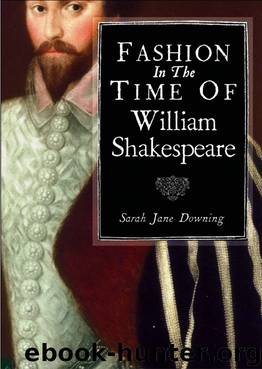Fashion in the Time of William Shakespeare by Sarah Downing

Author:Sarah Downing
Language: eng
Format: epub
Tags: Fashion in the Time of William Shakespeare
ISBN: 9781784420123
Publisher: Osprey Publishing
A German Courtier, c. 1580. As Shakespeare joked in Much Ado about Nothing, he is ‘… a German from the waist downward, all slops …’. He is also wearing his stockings cross-gartered like the unfortunate Malvolio.
It was bad form for a gentleman to appear in public without either a cloak or gown over his doublet. In Romeo and Juliet stage directions have Capulet making his entry ‘in his gown’ to denote the gravitas of his status. However, there was a general move away from the gown whose capacious folds and fur edges were so much a feature of Henry VIII’s court; by the 1570s this sober costume was more the province of older gentlemen, academics and town grandees.
For the sake of comfort and warmth at home, a full length silk or satin fur-lined gown was often worn. Known as a nightgown, it fell in folds suspended from a yoke, with a deep falling collar that turned into revers down the front edges, and the same hanging sleeves as a regular gown. It was a more attractive warm layer to be put on when going down to breakfast, or as in the Scottish play, when frolicking around a castle at night trying to cover up a murder! Lady Macbeth hears knocking at the south entry after Duncan’s murder; she tells her husband:
Get on your nightgown, lest occasion call us
And show us to be watchers.’
Worn with the insouciant casual air of one of Elizabeth’s favourite explorers, the cloak became the most glamorous and often most expensive item of male apparel. The Spanish cloak was short but full and had a hood, although often more for ornament than practicality; the Dutch cloak had wide sleeves which were left hanging loose, while the French cloak was the most dashing. Thrown nonchalantly over the left shoulder and fastened under the arm, it varied in length, reaching knee and even ankle length during the 1580s. It could be cut lavishly in a full circle, or ‘full compass’ or semicircular ‘half compass’ and it often also had a deep shoulder cape reaching to elbow length. The most ornate style of cloak, it was often decorated with bugle beads or pearls, or ‘guarded’ with bands of velvet or lace.
In The Tempest the ‘glistering apparel’ of Prospero’s wardrobe on the boat included a jerkin and a gown that Caliban, Stephano and Trinculo dressed themselves in. Caliban also had a long voluminous cloak described as a gabardine. This was not an unusual garment for Venetians of professional rank, but Jewish people were forced to wear it with a yellow hood to denote the ‘shame’ of their race and religion. When Antonio comes to borrow money from Shylock in The Merchant of Venice, the moneylender is reluctant to fulfil his request, reminding him that not days before, he spat upon his ‘Jewish gaberdine’ with derision and called him a ‘cut-throat dogge’.
Download
This site does not store any files on its server. We only index and link to content provided by other sites. Please contact the content providers to delete copyright contents if any and email us, we'll remove relevant links or contents immediately.
| Advertising | Annuals |
| Book Design | Branding & Logo Design |
| Fashion Design | Illustration |
| Science Illustration |
Wonder by R.J. Palacio(8446)
Mastering Adobe Animate 2023 - Third Edition by Joseph Labrecque(3756)
Unlabel: Selling You Without Selling Out by Marc Ecko(3587)
Ogilvy on Advertising by David Ogilvy(3503)
Hidden Persuasion: 33 psychological influence techniques in advertising by Marc Andrews & Matthijs van Leeuwen & Rick van Baaren(3472)
Drawing Cutting Edge Anatomy by Christopher Hart(3450)
The Pixar Touch by David A. Price(3362)
POP by Steven Heller(3306)
The Code Book by Simon Singh(3070)
The Art of War Visualized by Jessica Hagy(2943)
Slugfest by Reed Tucker(2936)
The Curated Closet by Anuschka Rees(2911)
Rapid Viz: A New Method for the Rapid Visualization of Ideas by Kurt Hanks & Larry Belliston(2832)
Stacked Decks by The Rotenberg Collection(2808)
365 Days of Wonder by R.J. Palacio(2751)
The Wardrobe Wakeup by Lois Joy Johnson(2731)
Keep Going by Austin Kleon(2696)
Tattoo Art by Doralba Picerno(2599)
Tell Me More by Kelly Corrigan(2591)
